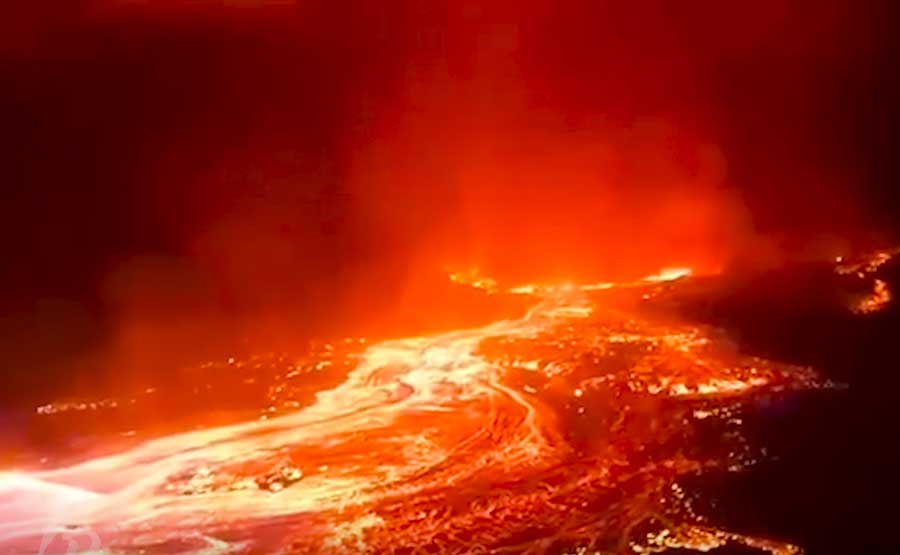Hundreds of children are feared missing or were separated from their families after Mount Nyiragongo erupted in the eastern Democratic Republic of Congo on Saturday.
The United Nations Children’s Emergency Fund (UNICEF) said Sunday that the children were lost amid chaos as residents fled the nearby city of Goma. More than 150 children have been separated from their families and more than 170 children are feared to be missing, the agency said.
Around 8,000 people crossed into Rwanda from the Democratic Republic of Congo (DRC) to seek refuge following the eruption of the volcano, Rwanda’s Emergency Management Ministry said Sunday.
“This morning, after lava flows from Nyiragongo volcano have stopped, most of Congolese evacuated to Rubavu are returning back home. Rwanda received around 8000 people last night,” the ministry said on its official Twitter account.
Thousands of residents in Goma spent the night outdoors following eruption on Saturday, according to a spokesperson for the Norwegian Refugee Council (NRC).
“There has not been a massive panic movement, but people are really worried,” said Tom Peyre-Costa, the council’s spokesperson for west and central Africa.

Evacuees first walked toward Rwanda, Peyre-Costa told CNN. The border was closed, so they went back to Goma and headed to an area north of the city. Peyre-Costa posted to Twitter video of people leaving the city
“Everywhere in the city you see people walking with their belongings, their children and even their goats and whatever they could grab. Most of them are just sitting by the road waiting to be able to go back any time soon,” Peyre-Costa said.
But hundreds could return to find damaged homes and dangerous shortages of water and electricity, UNICEF said.
The children’s agency is sending a team to the area to work on limiting the spread of cholera. It is also establishing two transit centers for unaccompanied and separated children, in collaboration with the local Congolese authorities.
A deadly eruption
Altogether, 11 people died in the aftermath of the eruption, officials said.
Five people died in a car accident when they tried to evacuate, Peyre-Costa told CNN.
Four prisoners also died while trying to escape from Camp Munzenze prison following the eruption, government spokesperson Patrick Muyaya told CNN. He said the prisoners were “trying to escape and could have clashed with guards.”
Muyaya said another two people died on Sunday, but did not elaborate on the circumstances.
Six-hundred homes around Goma have been destroyed and five schools flattened, according to NRC estimates.
The volcanic eruption seems to have subsided, according to the Goma Volcano Observatory, which monitors the volcano. Authorities in the city activated an evacuation plan as a precaution.
“We arrived quickly, we didn’t expect these kinds of things which just happened to us,” Theophile Tulinabo, a resident who fled his home after the eruption, told CNN in Buhene, a neighborhood north of Goma. “And where are we going to live now? At the moment, we don’t know.”

Furaha Grace, another resident speaking to CNN in Buhene, said she was in the local market when she had to run from the eruption.
“When we returned to the city the houses were burnt and some people were left destitute. I got into an accident and got hurt,” she said. “So we’re appealing for assistance and especially for food.”
The volcano’s last major eruption in 2002 killed 250 people and displaced thousands.
Goma is on the edge of Lake Kivu on the Democratic Republic of Congo’s border with Rwanda. The current metro area population of Goma in 2021 is 670,000, according to a projection by the UN, World Bank and others.
Peyre-Costa said a number of nongovernmental organizations in the region believe Goma’s population is closer to 1 million.
Patrick Kakesa of the International NGO Safety Organisation (INSO) said in a statement at 11 p.m. that the lava appears to be flowing towards the border with Rwanda.
“In the event of an evacuation, customs between Goma and Gisenyi are closed overnight,” he said.
INSO advised humanitarian workers living in the Munigi camp a short distance from northern Goma to move to villages further to the west.


